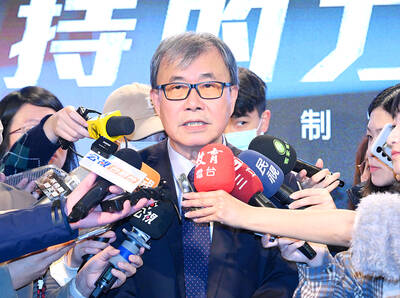The Mainland Affairs Council (MAC) yesterday played down a row between China and Japan over the Diaoyutai Islands (釣魚台), insinuating that China would not use economic means to resolve cross-strait disputes if both sides continue to build mutual trust through institutionalized negotiations.
Asked to comment on the crisis and what it implied for Beijing’s approach to Taiwan, Mainland Affairs Council Deputy Minister Liu Te-shun (劉德勳) was evasive about whether the administration of President Ma Ying-jeou (馬英九) was worried about the possibility that Beijing would use economic means to settle disputes, as it has been doing with Tokyo.
“What I see now is that both sides have built more trust through institutionalized negotiations,” Liu said. “The more solid we build the foundation, the more cross-strait stability will develop.”
Japan had intended to prosecute the captain of a Chinese fishing boat that collided with two Japanese Coast Guard vessels in disputed waters off the Diaoyutais two weeks ago. Amid mounting pressure from Beijing, Tokyo decided to release the captain, angering many Japanese, who described the decision as foolish and humiliating.
Immediately following the release of the skipper, Beijing demanded an apology and compensation, requests that Tokyo categorically rejected.
Liu said the reason Taipei and Beijing had signed 14 agreements — including the Economic Cooperation Framework Agreement (ECFA) in June — over the past two years was to resolve the longstanding problem of a trade imbalance in the Taiwan Strait.
As all the agreements were negotiated through an institutionalized platform, Liu said, they would help normalize cross-strait trade and make business activity across the Strait “more systematic.”
As the agreements include different channels of communication and negotiation, they would be conducive to fixing future problems generated by economic exchanges, he said.
As for economic development, Liu said the entire world was facing the same problem of changing regional structures.
“Every country will find the best way to adjust itself to help its own economic development,” he said.
In related news, Liu said Taipei and Beijing were still negotiating details of the planned cross-strait economic cooperation committee, which is to be formed within six months of the ECFA coming into force on Sept. 12.
The committee will handle negotiations, implementation, application and interpretation of the agreement or disputes resulting from it.
Topping the agenda are planned discussions on agreements on investment protection, trade in commodities, services and a dispute-resolving mechanism, as stipulated in the ECFA.
On Sept. 15, the council authorized the Straits Exchange Foundation (SEF) to begin negotiations on the formation of the committee and upcoming talks between SEF Chairman Chiang Pin-kung (江丙坤) and his Chinese counterpart, Association for Relations Across the Taiwan Strait Chairman Chen Yunlin (陳雲林).
Chiang and Chen are expected to sign an investment protection pact and an agreement on medical and healthcare cooperation later this year.

STILL COMMITTED: The US opposes any forced change to the ‘status quo’ in the Strait, but also does not seek conflict, US Secretary of State Marco Rubio said US President Donald Trump’s administration released US$5.3 billion in previously frozen foreign aid, including US$870 million in security exemptions for programs in Taiwan, a list of exemptions reviewed by Reuters showed. Trump ordered a 90-day pause on foreign aid shortly after taking office on Jan. 20, halting funding for everything from programs that fight starvation and deadly diseases to providing shelters for millions of displaced people across the globe. US Secretary of State Marco Rubio, who has said that all foreign assistance must align with Trump’s “America First” priorities, issued waivers late last month on military aid to Israel and Egypt, the

‘UNITED FRONT’ FRONTS: Barring contact with Huaqiao and Jinan universities is needed to stop China targeting Taiwanese students, the education minister said Taiwan has blacklisted two Chinese universities from conducting academic exchange programs in the nation after reports that the institutes are arms of Beijing’s United Front Work Department, Minister of Education Cheng Ying-yao (鄭英耀) said in an exclusive interview with the Chinese-language Liberty Times (the Taipei Times’ sister paper) published yesterday. China’s Huaqiao University in Xiamen and Quanzhou, as well as Jinan University in Guangzhou, which have 600 and 1,500 Taiwanese on their rolls respectively, are under direct control of the Chinese government’s political warfare branch, Cheng said, citing reports by national security officials. A comprehensive ban on Taiwanese institutions collaborating or

France’s nuclear-powered aircraft carrier and accompanying warships were in the Philippines yesterday after holding combat drills with Philippine forces in the disputed South China Sea in a show of firepower that would likely antagonize China. The Charles de Gaulle on Friday docked at Subic Bay, a former US naval base northwest of Manila, for a break after more than two months of deployment in the Indo-Pacific region. The French carrier engaged with security allies for contingency readiness and to promote regional security, including with Philippine forces, navy ships and fighter jets. They held anti-submarine warfare drills and aerial combat training on Friday in

COMBAT READINESS: The military is reviewing weaponry, personnel resources, and mobilization and recovery forces to adjust defense strategies, the defense minister said The military has released a photograph of Minister of National Defense Wellington Koo (顧立雄) appearing to sit beside a US general during the annual Han Kuang military exercises on Friday last week in a historic first. In the photo, Koo, who was presiding over the drills with high-level officers, appears to be sitting next to US Marine Corps Major General Jay Bargeron, the director of strategic planning and policy of the US Indo-Pacific Command, although only Bargeron’s name tag is visible in the seat as “J5 Maj General.” It is the first time the military has released a photo of an active